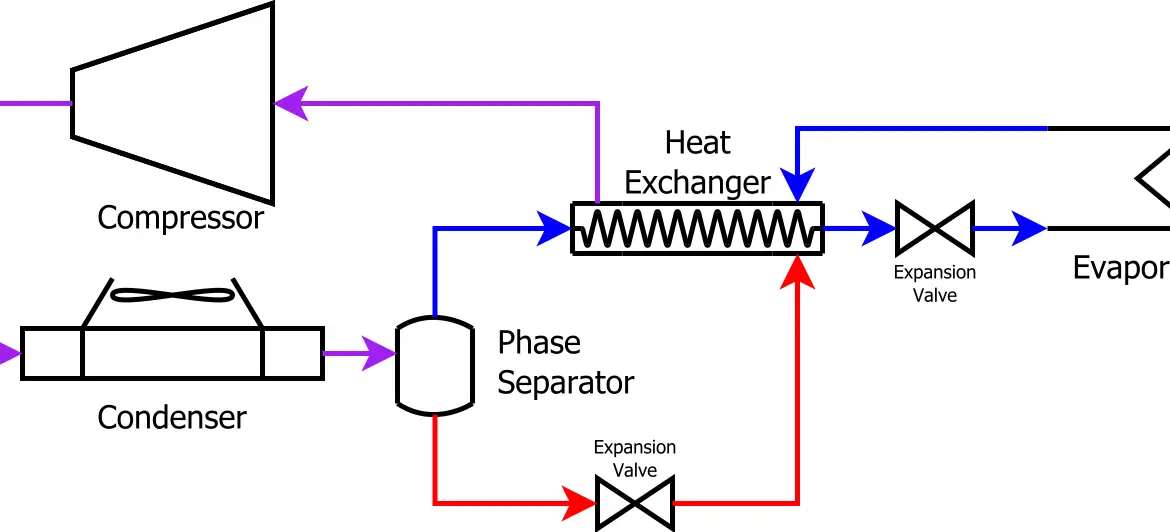Subcooling and superheating in refrigeration might sound like a mouthful, but it’s something every homeowner should be familiar with. Why? Because these two processes play a vital role in keeping your fridge, freezer, and air conditioning systems running smoothly and efficiently.
So, let’s dive into the world of subcooling and superheating and learn how to make the most out of our cooling systems.

Table of Contents
Basics of Refrigeration
Before we jump into subcooling and superheating, let’s quickly cover how refrigeration systems work. These systems rely on a refrigeration cycle, where refrigerant changes between liquid and gas states, absorbing and releasing heat in the process.
This cycle is essential for keeping your home cool and your food fresh. In a nutshell, refrigeration is all about heat transfer, and subcooling and superheating play a huge role in it.
Defining Subcooling and Superheating
So, what is subcooling and superheating? Subcooling is when the refrigerant is cooled below its boiling point, while superheating is when the refrigerant is heated above its boiling point. Both processes are crucial for the efficiency and performance of your refrigeration system.
Understanding Subcooling and Superheat
The Role of Subcooling in Refrigeration
Let’s start with subcooling. This process helps improve your refrigeration system’s efficiency by increasing the capacity of the refrigerant and reducing the formation of flash gas. In other words, subcooling helps your cooling system work harder and better. It’s like giving your fridge a superpower!
Factors Affecting Subcooling
But what affects subcooling? A few things, actually. The size and efficiency of your condenser, the refrigerant charge, and the ambient temperature all play a role. Think of it like a delicate dance – if one partner is offbeat, the whole performance suffers.
The Role of Superheating in Refrigeration
Now let’s talk about superheating. Superheating ensures that all the refrigerant evaporates before it reaches the compressor. This protects your compressor from damage and maximizes the cooling capacity of your system. So, superheating is like a trusty sidekick that helps your cooling system stay in tip-top shape.
Factors Affecting Superheating
Similar to subcooling, several factors affect superheating, including the evaporator size and efficiency, refrigerant charge, and system load. Keeping these factors in check helps maintain the perfect balance for optimal cooling performance.
Subcooling and Superheat Explained
Measuring Subcooling and Superheating
Now that you know the importance of subcooling and superheating, how do you measure them? You’ll need some specialized tools and equipment, like a thermometer and pressure gauge. But don’t worry, there are plenty of tutorials and resources online to help you out.
Troubleshooting Tips
Encountering issues with your subcooling and superheating levels? Fear not! Some common problems include incorrect refrigerant charge, poor airflow, and dirty condenser coils. By learning how to identify and address these issues, you’ll be well on your way to keeping your cooling systems in perfect working order.
Proper Refrigeration Superheat and Subcooling
So, what are the ideal levels of subcooling and superheating for your refrigeration system? It depends on several factors, including the type of system, the refrigerant used, and the ambient conditions. By understanding these factors and making necessary adjustments, you can optimize your system for peak performance and efficiency. Remember, it’s all about finding that sweet spot!
Applications of Subcooling and Superheating in Refrigeration
Residential and Commercial Refrigeration
Subcooling and superheating play a crucial role in various residential and commercial refrigeration applications, such as air conditioning systems, refrigerators and freezers, and walk-in coolers. By maintaining optimal levels of subcooling and superheating, you can ensure that your cooling systems work efficiently and keep your energy bills in check.
Industrial Refrigeration
In industrial settings, subcooling and superheating are also essential for maintaining the efficiency of cooling systems used in cold storage facilities, food processing plants, and pharmaceutical manufacturing. Proper subcooling and superheating management can help these industries save energy and reduce operating costs.
Transportation Refrigeration
Even in transportation refrigeration systems, such as shipping containers, refrigerated trucks, and marine refrigeration units, subcooling and superheating play a vital role. By optimizing these processes, companies can ensure that their products are transported safely and efficiently, without compromising on quality.
Conclusion
The Importance of Subcooling and Superheating in Refrigeration
In summary, subcooling and superheating are essential for the efficiency and longevity of your refrigeration systems. By understanding their roles and how to manage them properly, you can optimize your cooling systems and keep them running smoothly for years to come. So, stay cool, and don’t forget to give your cooling systems the love and attention they deserve!